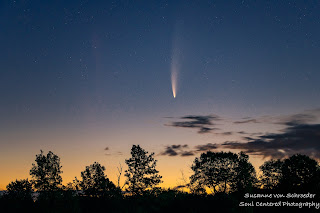The Comet 'Neowise" is the most exciting comet in the northern hemisphere since Hale-Bopp in 1997. I don't remember if I saw Hale-Bopp so I wanted to make sure to see and photograph Neowise. I did some research online and read that a good time to view the comet is 45 minutes before sunrise looking towards north east, pretty low on the horizon.
On day one (July 11) I arrived at my location an hour before sunrise but was not able to see the comet. The sky was already too bright. I decided to wait for the sunrise - with hundreds of mosquitos buzzing around me.
On day 2 (July 12) I got up earlier and went to an open field not far from my home and arrived there at 3:30am. I spotted the comet right away - wow, what a beautiful sight!
I stayed until 4:15am and headed home.
On day 3 (July 13) I wanted to go to a lake and see if I could capture the comet reflecting in the water. I had to get up at 2am to arrive in time at the Chippewa Flowage (Wisconsin).
I am so glad I put in the effort as the view was breathtaking. To stand in the dark and listen to the night sounds, watching a comet with a long tail is quite a special experience.
On my way home I stopped at a few places to capture the colors of dawn and the sunrise at a bog.
The comet Neowise will still be around through the month of July and can be seen in the evenings after sunset looking towards north west.
Addition on July 16: I added 4 more photos from an outing on July 15 in the evening. Best time of viewing was 10:30-11pm, towards North North West.
It was a very peaceful and quiet night at a lake in the Blue Hills. I heard frogs, splashes in the water and a loon. The fireflies were dancing (the mosquitos as well, ha, ha...) - very magical!!
Some more tit bids I found online:
When was NEOWISE first discovered? Comet C/2020 F3 (NEOWISE) was discovered on March 27, 2020 – not from Earth’s surface – but from by a space observatory some 326 miles (525 km) above Earth’s surface. It’s named for its discoverer, the Near Earth Object Wide-field Infrared Survey Explorer, aka NEOWISE, which was launched by NASA in 2009.
Comet NEOWISE was closest to the sun on July 3, 2020, passing at about 26.7 million miles (43 million km) from the sun, or a bit closer than the average distance from the sun to Mercury. Unlike some comets, it survived the close encounter with our star and went on to become widely seen by binocular observers and astrophotographers.
Enjoy, Susanne
Click on the photos for a larger view. Interested in purchasing a print? go to my website: www.soulcenteredphotography.net
Get 15% off with code Beauty2020, minimum purchase $35
Get 15% off with code Beauty2020, minimum purchase $35
 |
| Sunrise in the Blue Hills (near Exeland) on day 1 |
 |
| Comet Neowise -day 2 at 3:45am |
 |
| Comet Neowise -day 2 at 3:50am |
 |
| Comet Neowise -day 3 at 3:37am, Reflecting in the water (Chippewa Flowage) |
 |
| Comet Neowise -day 3 at 3:38am, Chippewa Flowag |
 |
| Comet Neowise -day 3 at 3:57am with Venus to the right, Chippewa Flowage |
 |
| Colors of dawn and fog - Chippewa Flowage |
 |
| Colors of dawn and fog - Chippewa Flowage |
 |
| Colors of dawn - Couderay River near Radisson, Wisconsin |
 |
| Sunrise in a bog |
 |
| Sunrise in a bog |
 |
| Comet Neowise, July 15 at 10:30pm, in the Blue Hills, WI |
 |
| Comet Neowise, July 15 at 11pm, in the Blue Hills, WI, photobombed by a firefly |
 |
| Comet Neowise with reflections in a lake, July 15 at 11pm, in the Blue Hills, WI |
 | |
|

No comments:
Post a Comment